One of the primary reasons dentists recommend having regular professional dental cleanings and preach practicing good oral hygiene at home is to prevent the development of periodontal disease and all of the general health issues that are directly related to it.
What Is Periodontal Disease?
Periodontal disease (also sometimes called gum disease or dental disease) is a bacterial infection of the gums. It can develop when plaque hardens into tartar (also called calculus) that accumulates on the surface of the teeth. This accumulation of calculus pushes the gums away from the teeth, creating pockets where harmful bacteria take up residence and multiply.
Left unaddressed, gum disease can cause several local symptoms such as tooth sensitivity, receding gums, bad breath, bleeding gums, swollen gums, and sore gums in addition to tooth decay, loose teeth, and tooth loss. In addition to increasing a person’s risk for respiratory infections, periodontal disease can also lead to the spread of bacteria throughout the body via the bloodstream, increasing the risk of a variety of systemic health issues such as cardiovascular disease, diabetes, rheumatoid arthritis, dementia, certain cancers, and reproductive health problems.
The 4 Stages of Periodontal Disease
Like many diseases, periodontal disease progresses through a variety of development stages that range from mild to severe. The symptoms and treatment approaches of periodontal disease differ from stage to stage.
1. Gingivitis
Gingivitis results from the accumulation of plaque on the surfaces of the teeth. Although gingivitis is usually mild and often causes no noticeable symptoms, it can result in bleeding gums and some minor tooth sensitivity. Since the symptoms are mild, most people do not even realize that they have gingivitis until they visit the dentist for a prophylactic cleaning and checkup.
Gingivitis can be fairly easily addressed and reversed with improved oral hygiene practices at home and regular dental hygiene appointments. This is one of the reasons why it’s essential to visit the dentist regularly because regular checkups ensure that periodontal disease is detected in its earliest stage when it is still simple to address.
2. Slight Periodontal Disease
If periodontal disease is not adequately addressed at the gingivitis stage, it develops into slight periodontal disease. Slight periodontal disease is characterized by the bacterial infection having reached the bones and periodontal ligaments of the patient. During this stage, the bacteria begin to become destructive, leading to subsequent bone loss and deterioration.
Unfortunately, once the infection has reached this stage, it cannot be completely cured and reversed. It can, however, at least be managed. Treatment at this stage involves a deeper cleaning of the gums, teeth, and tooth roots called scaling. Root planing, which is a treatment designed to smooth out the crevices and grooves of the tooth roots, is usually also recommended at this stage.
Scaling and root planing help to remove bacteria and diseased tissues from the gums while also making it more difficult for bacteria to continue to flourish.
3. Moderate Periodontal Disease
Moderate periodontal disease has similar symptoms and treatments as slight periodontal disease. In this stage, however, the bacteria will have reached even deeper into the patient’s gums, tissues, and tooth root systems.
4. Advanced Periodontal Disease
When it has reached its most advanced stage, periodontal disease is considered a severe, serious bacterial infection. Symptoms include gums that ooze pus, loose teeth, tooth loss, severe pain and sensitivity, severe gum recession, and the deterioration of the jawbone. Additionally, advanced periodontal disease can lead to sepsis, systemic infections, and inflammation-related diseases throughout the body.
When periodontal disease has reached stage 4, surgery to remove dead and diseased tissues while sterilizing bacteria beneath the gums is necessary to get the infection under control.
What You Can Do to Prevent Periodontal Disease
As with most health concerns, prevention is always the best strategy. When it comes to dealing with gum disease, stopping it before it gets started is the most ideal strategy. We place a strong emphasis on proactive, preventive dental care designed to help our patients combat gum disease.
The best thing you can do, in addition to visiting the dentist for a professional cleaning every six months, is to practice excellent oral hygiene at home by brushing at least twice a day for two minutes, using the proper brushing technique, and flossing daily as well. If you’re at risk of developing gum disease, we might also recommend rinsing daily with an alcohol-free antibacterial mouthwash.
Periodontal Disease Treatment in West Bend
At Dentistry of West Bend, we always emphasize the importance of being proactive about your dental health with periodontal disease prevention. However, when a patient does develop periodontal disease, we have a variety of treatments available that are designed to address periodontal disease at any stage. This includes more frequent dental cleaning appointments and at-home oral hygiene education for patients with gingivitis in addition to scaling and root planing, antibacterial trays, and gum disease laser therapy for more advanced cases.
To learn more about the various stages of periodontal disease and what you can do to protect your oral health, we welcome you to contact Dentistry of West Bend to schedule an appointment with Dr. Jared Harding.


Recent Comments